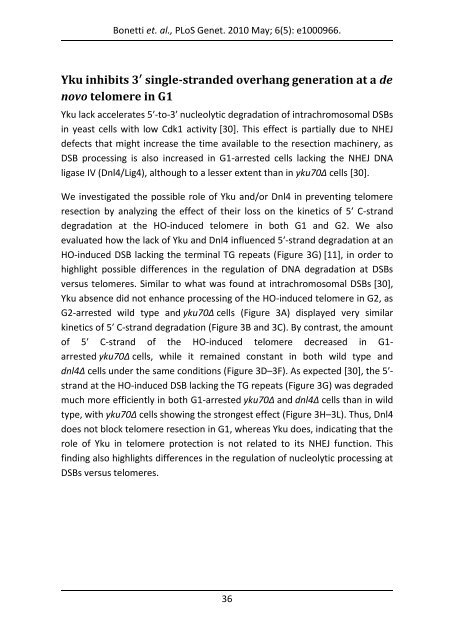View/Open - Università degli Studi di Milano-Bicocca
View/Open - Università degli Studi di Milano-Bicocca
View/Open - Università degli Studi di Milano-Bicocca
Create successful ePaper yourself
Turn your PDF publications into a flip-book with our unique Google optimized e-Paper software.
Bonetti et. al., PLoS Genet. 2010 May; 6(5): e1000966.<br />
Yku inhibits 3′ single-stranded overhang generation at a de<br />
novo telomere in G1<br />
Yku lack accelerates 5′-to-3′ nucleolytic degradation of intrachromosomal DSBs<br />
in yeast cells with low Cdk1 activity [30]. This effect is partially due to NHEJ<br />
defects that might increase the time available to the resection machinery, as<br />
DSB processing is also increased in G1-arrested cells lacking the NHEJ DNA<br />
ligase IV (Dnl4/Lig4), although to a lesser extent than in yku70Δ cells [30].<br />
We investigated the possible role of Yku and/or Dnl4 in preventing telomere<br />
resection by analyzing the effect of their loss on the kinetics of 5′ C-strand<br />
degradation at the HO-induced telomere in both G1 and G2. We also<br />
evaluated how the lack of Yku and Dnl4 influenced 5′-strand degradation at an<br />
HO-induced DSB lacking the terminal TG repeats (Figure 3G) [11], in order to<br />
highlight possible <strong>di</strong>fferences in the regulation of DNA degradation at DSBs<br />
versus telomeres. Similar to what was found at intrachromosomal DSBs [30],<br />
Yku absence <strong>di</strong>d not enhance processing of the HO-induced telomere in G2, as<br />
G2-arrested wild type and yku70Δ cells (Figure 3A) <strong>di</strong>splayed very similar<br />
kinetics of 5′ C-strand degradation (Figure 3B and 3C). By contrast, the amount<br />
of 5′ C-strand of the HO-induced telomere decreased in G1arrested<br />
yku70Δ cells, while it remained constant in both wild type and<br />
dnl4Δ cells under the same con<strong>di</strong>tions (Figure 3D–3F). As expected [30], the 5′strand<br />
at the HO-induced DSB lacking the TG repeats (Figure 3G) was degraded<br />
much more efficiently in both G1-arrested yku70Δ and dnl4Δ cells than in wild<br />
type, with yku70Δ cells showing the strongest effect (Figure 3H–3L). Thus, Dnl4<br />
does not block telomere resection in G1, whereas Yku does, in<strong>di</strong>cating that the<br />
role of Yku in telomere protection is not related to its NHEJ function. This<br />
fin<strong>di</strong>ng also highlights <strong>di</strong>fferences in the regulation of nucleolytic processing at<br />
DSBs versus telomeres.<br />
36

















